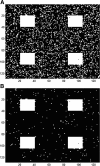Application of mean-shift clustering to blood oxygen level dependent functional MRI activation detection
- PMID: 24495795
- PMCID: PMC3917895
- DOI: 10.1186/1471-2342-14-6
Application of mean-shift clustering to blood oxygen level dependent functional MRI activation detection
Abstract
Background: Functional magnetic resonance imaging (fMRI) analysis is commonly done with cross-correlation analysis (CCA) and the General Linear Model (GLM). Both CCA and GLM techniques, however, typically perform calculations on a per-voxel basis and do not consider relationships neighboring voxels may have. Clustered voxel analyses have then been developed to improve fMRI signal detections by taking advantages of relationships of neighboring voxels. Mean-shift clustering (MSC) is another technique which takes into account properties of neighboring voxels and can be considered for enhancing fMRI activation detection.
Methods: This study examines the adoption of MSC to fMRI analysis. MSC was applied to a Statistical Parameter Image generated with the CCA technique on both simulated and real fMRI data. The MSC technique was then compared with CCA and CCA plus cluster analysis. A range of kernel sizes were used to examine how the technique behaves.
Results: Receiver Operating Characteristic curves shows an improvement over CCA and Cluster analysis. False positive rates are lower with the proposed technique. MSC allows the use of a low intensity threshold and also does not require the use of a cluster size threshold, which improves detection of weak activations and highly focused activations.
Conclusion: The proposed technique shows improved activation detection for both simulated and real Blood Oxygen Level Dependent fMRI data. More detailed studies are required to further develop the proposed technique.
Figures





References
Publication types
MeSH terms
Substances
Grants and funding
LinkOut - more resources
Full Text Sources
Other Literature Sources
Medical

